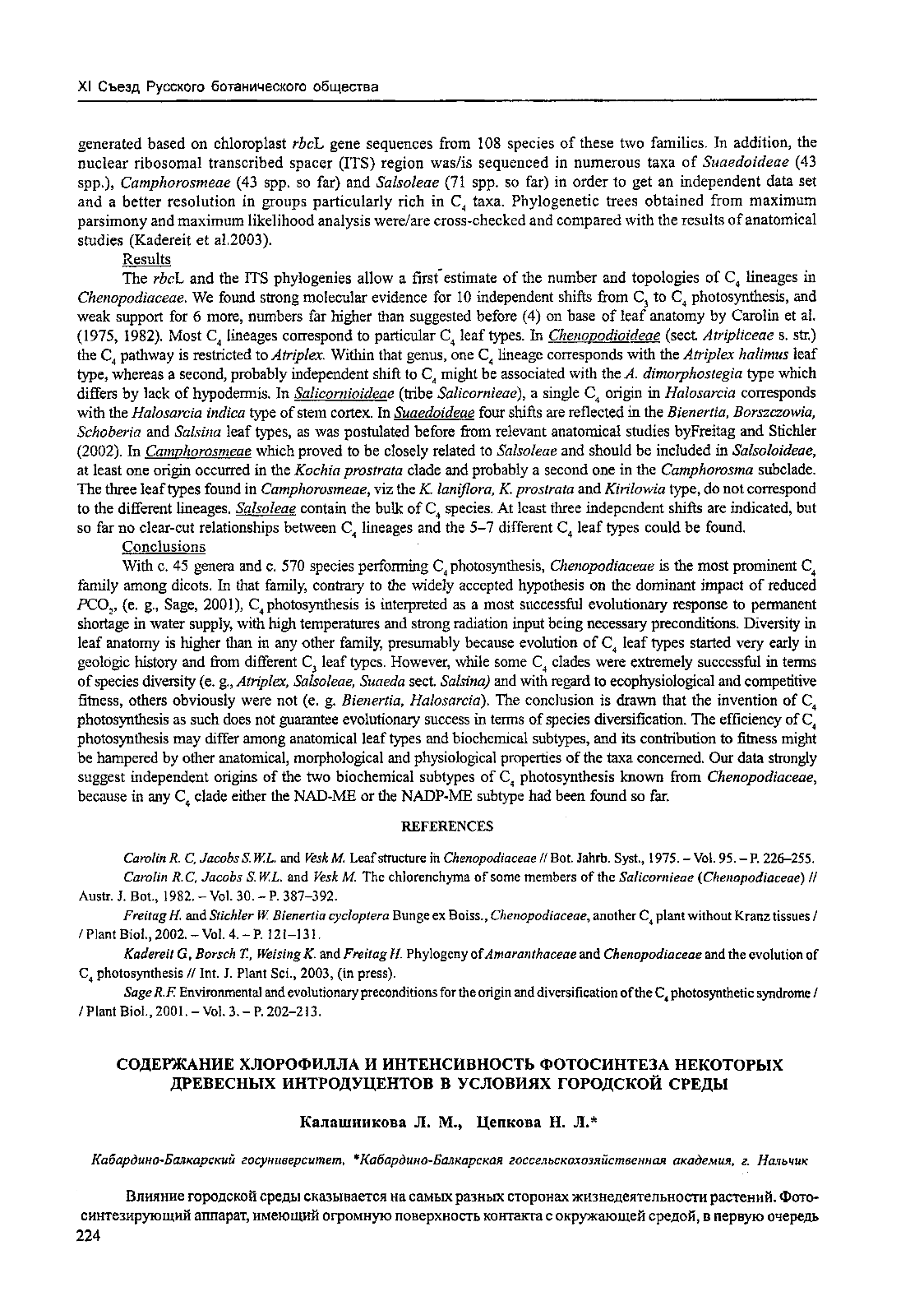

XI Съезд Русского ботанического общества
generated based on chloroplast
rbcL
gene sequences from 108 species of these two families. In addition, the
nuclear ribosomal transcribed spacer (ITS) region was/is sequenced in numerous taxa o f
Suaedoideae
(43
spp.),
Camphorosmeae
(43 spp. so far) and
Salsoleae
(71 spp. so far) in order to get an independent data set
and a better resolution in groups particularly rich in C4 taxa. Phylogenetic trees obtained from maximum
parsimony and maximum likelihood analysis were/are cross-checked and compared with the results of anatomical
studies (Kadereit et al.2003).
Results
The
rbcL
and the ITS phytogenies allow a first"estimate of the number and topologies of C4 lineages in
Chenopodiaceae
. We found strong molecular evidence for 10 independent shifts from C3 to C4 photosynthesis, and
weak support for 6 more, numbers far higher than suggested before (4) on base of leaf anatomy by Carolin et al.
(1975, 1982). Most C4 lineages correspond to particular C4 leaf types. In
Chenovodioideae
(sect
Atripliceae
s. str.)
the C4pathway is restricted to
Atriplex.
Within that genus, one C4 lineage corresponds with the
Atriplex halimus
leaf
type, whereas a second, probably independent shift to C4might be associated with the
A. dimorphostegia
type which
differs by lack of hypodermis. In
Saiicomioideae
(tribe
Salicornieae
), a single C4 origin in
Halosarcia
corresponds
with the
Halosarcia indica
type of stem cortex. In
Suaedoideae
four shifts are reflected in the
Bienertia, Borszczowia,
Schoberia
and
Salsina
leaf types, as was postulated before from relevant anatomical studies byFreitag and Stichler
(2002). In
Camphorosmeae
which proved to be closely related to
Salsoleae
and should be included in
Salsoloideaef
at least one origin occurred in the
Kochia prostrata
clade and probably a second one in the
Camphorosma
subclade.
The three leaf types found in
Camphorosmeae
, viz the
K. laniflora
,
K. prostrata
and
Kirilowia
type, do not correspond
to the different lineages.
Salsoleae
contain the bulk of C4 species. At least three independent shifts are indicated, but
so far no clear-cut relationships between C4 lineages and the 5-7 different C4 leaf types could be found.
Conclusions
With c. 45 genera and c. 570 species performing C4photosynthesis,
Chenopodiaceae
is the most prominent C4
family among dicots. In that family, contrary to the widely accepted hypothesis on the dominant impact of reduced
PCOv
(e. g., Sage, 2001), C4photosynthesis is interpreted as a most successful evolutionary response to permanent
shortage in water supply, with high temperatures and strong radiation input being necessary preconditions. Diversity in
leaf anatomy is higher than in any other family, presumably because evolution of C4 leaf types started very early in
geologic histoiy and from different C3 leaf types. However, while some C4 clades were extremely successful in terms
of species diversity (e. g.,
Atriplex
,
Salsoleae
,
Suaeda
sect.
Salsina)
and with regard to ecophysiological and competitive
fitness, others obviously were not (e, g.
Bienertia
,
Halosarcia
). The conclusion is drawn that the invention of C4
photosynthesis as such does not guarantee evolutionary success in terms of species diversification. The efficiency of C4
photosynthesis may differ among anatomical leaf types and biochemical subtypes, and its contribution to fitness might
be hampered by other anatomical, morphological and physiological properties of the taxa concerned. Our data strongly
suggest independent origins of the two biochemical subtypes of C4 photosynthesis known from
Chenopodiaceae
,
because in any C4 clade either the NAD-ME or the NADP-ME subtype had been found so far.
REFERENCES
Carolin R. C, Jacobs S W.L
and
Vesk
M Leaf structure in
Chenopodiaceae
// Bot. Jahrb. Syst, 1975. - Vol. 95. - P. 226-255.
Carolin R.C
,
Jacobs S. W.L.
and
Vesk M.
The chlorenchyma of some members of the
Salicornieae
(
Chenopodiaceae)
//
Austr. J. Bot., 1982. - Vol. 30. - P. 387-392.
FreitagH.
and
Stichler W Bienertia cycloptera
Bunge ex Boiss.,
Chenopodiaceae
, another C4plant without Kranz tissues /
/ Plant Biol., 2002. - Vol. 4. - P. 121-131.
Kadereit G, Borsch XWeisingK.
and
FreitagH.
Phylogeny of
Amaranthaceae
and
Chenopodiaceae
and the evolution of
C4photosynthesis // Int. J. Plant Sci., 2003, (in press).
Sage R.F
Environmental and evolutionary preconditions for the origin and diversification of the C4photosynthetic syndrome /
/ Plant Biol., 2001. - Vol. 3. - P. 202-213.
СОДЕРЖАНИЕ ХЛОРОФИЛЛА И ИНТЕНСИВНОСТЬ ФОТОСИНТЕЗА НЕКОТОРЫХ
ДРЕВЕСНЫХ ИНТРОДУЦЕНТОВ В УСЛОВИЯХ ГОРОДСКОЙ СРЕДЫ
Калашникова Л. М., Цепкова Н. Л.*
Кабардино-Балкарский госуниверситет, *Кабардино-Балкарская госсельскохозяйственная академия
,
г. Нальчик
Влияние городской среды сказывается на самых разных сторонах жизнедеятельности растений. Фото
синтезирующий аппарат, имеющий огромную поверхность контакта с окружающей средой, в первую очередь
224
Электронная Научная СельскоХозяйственная Библиотека









